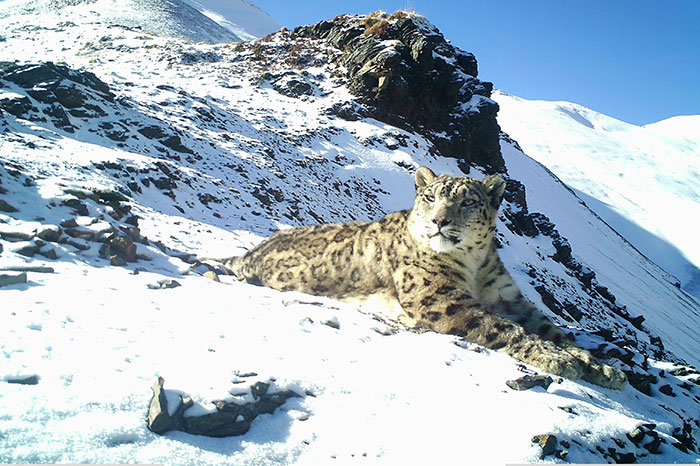Choki Wangmo
The threat to snow leopard (Panthera uncia) in Bhutan is ‘very high’, with threats to population and habitat ranked as ‘high’ in the overall threat analysis and priority ranking of the species according to the snow leopard conservation action plan 2018-2023.
The population of the elusive species, found in northern Bhutan above 4,000 metres above sea level in the five protected areas is threatened by changing climate, degradation of alpine meadows, habitat loss and fragmentation, natural disasters, retaliatory killing, feral dogs, wild prey depletion, and diseases, among others.
The five-year action plan reported that one of the challenges to snow leopard conservation was the proximity to international borders with China and India. “The market demand for snow leopard and other wildlife parts and products in the illegal international market is high, and monitoring, patrolling, and protection along the long, porous border is extremely difficult, especially with the small protected areas cadre.”
Bhutan conducted its first nationwide survey of snow leopards from 2014 to 2016 using grid-based sign surveys and camera traps and counted the total population at 96 individuals. Most animals were in the western alpine regions, especially in Jigme Dorji National Park (JDNP), Wangchuck Centennial National Park, and Jigme Khesar Strict Nature Reserve.
The next population survey is expected to be conducted next year.
An official from nature conservation division said that globally, the snow leopard is threatened by habitat loss, poaching, and retaliation but in Bhutan, threats to snow leopard are not very severe. “But we do have threats of habitat degradation in the face of climate change. More research is required to ascertain the severity of threats. Snow leopard predating livestock which results in human-wildlife conflict issues is a challenge.”
The recorded numbers of the species was much lower than previous surveys conducted in JDNP, where the population was estimated at 192 animals.
By the end of the action plan, the official said that there should be strengthened monitoring of snow leopard population in the country to understand its population trends. “We are also expecting that habitat improvement of snow leopard prey species will be there.”
Under the action plan, the majority of the works were funded through Bhutan for Life project with key activities which includes monitoring of the animal through SMART patrolling, community awareness programmes, and supporting community initiatives.
In its social media page, Bhutan For Life (BLF) wrote that the organisation continues its effort to maintain a stable and thriving population of key species contributing to national and global biodiversity goals. “A specific milestone is dedicated to the conservation of key megafauna species and strives to maintain a stable population of snow leopard.”
BLF funded Nu 9.087 million to procure 300 camera traps and accessories.
In the future, the organisation aims to fund population estimates, prey-based assessments and developing climate-smart conservation plans for snow leopard.
The snow leopard range countries convened in Bishkek, Kyrgyzstan to agree on a global snow leopard conservation plan and strategy in 2013.
Through Bishkek Declaration, the countries aimed to commit to actions for a collective and holistic action plan to conserve snow leopards and their habitats, with ecosystem service-related benefits to local communities.
In Bhutan, the species is in the totally protected species in Schedule I of the Forest and Nature Conservation Act of Bhutan, 1995.
The snow leopard is considered an apex predator, an umbrella species, and a flagship species of the alpine ecosystems of the Himalayas.
In observing the international snow leopard day yesterday, World Wildlife Fund reported that the species is killed for its fur and bones in which 4-8 snow leopards are killed every week. Almost 50 percent of these are in retaliation to livestock predation.
The species is vulnerable in the IUCN Red List and the total wild population is estimated at 4000-6000 individuals.


